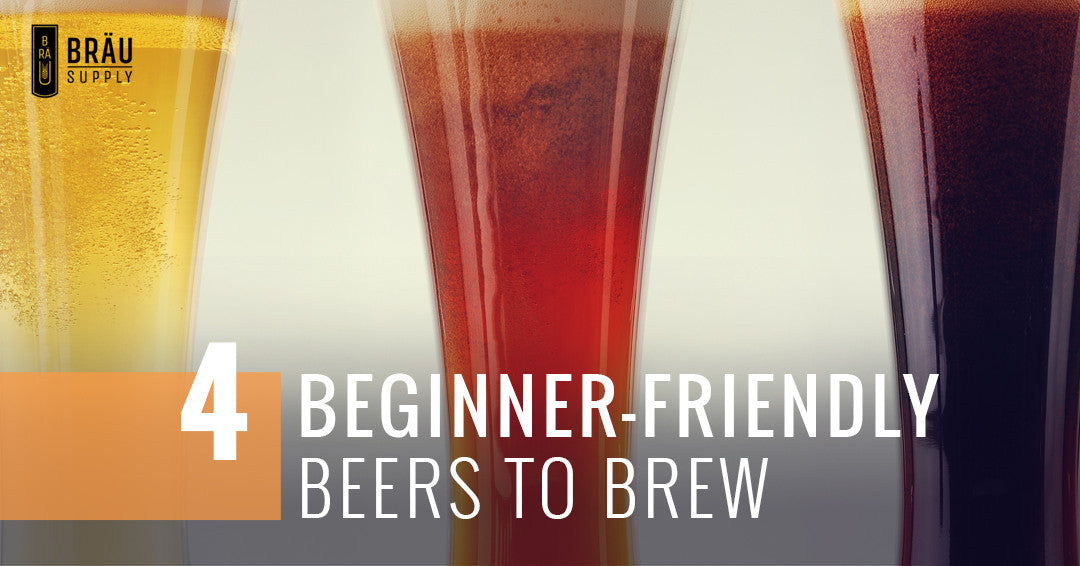Boxing weekend sale! Save up to $700! Shop now Our products ship tariff free

4 Beginner-Friendly Beers to Brew
June 02, 2017 3 min read

If you love double IPAs or imperial stouts, you may be eager to try creating your favorite type of beer when you are jumping into the world of home brewing. However, when you are a beginner brewer, it is better to try a simpler style first. This will ensure that you do not get too discouraged, and that you do not waste your ingredients and efforts on a beer on your first try. You are bound to make a mistake or two during your first attempt, so it is best to go for a style of beer that is going to be more forgiving than the more complex recipes. Remember, just because a beer is simpler to make, doesn’t make it any less fun to brew! In this blog, we will go over some beer styles that are easier for the beginner brewer to tackle.
American Wheat Ale
American wheat ale is the U.S.’s take on the popular German Hefeweizen. You can identify an American wheat ale by its light-to-medium body, cloudy appearance, and citrus, banana, and clove notes. The grain bill contains somewhere between 50 and 70 percent wheat, which creates a fluffiness in the beer that you can see in the head when it is poured. This is a style that is very popular in warmer weather, but it also works well year-round. Even people who aren’t “that into beer” will love American wheat ales.
Amber Ale
Amber ale has become increasingly popular among homebrewers, and it isn’t hard to understand why. This style of beer is accessible for even people who aren’t big beer drinkers because it isn’t too hoppy and is well-balanced in flavor. While it uses similar grains to pale ales, it is made using hops with lower alpha acid, which reduces the hop profile significantly. Malt is more of the star of the amber ale, which uses a darker roast malt in addition to lighter malt, creating the signature amber color and the notes of caramel and toffee. Best of all, amber ale recipes are among the most straightforward beer recipes.
Brown Ale
This simple style is perfect for the beginner home brewer who prefers a darker beer. There are both English and American styles of this popular beer, with the main difference being that American brown ales are more hoppy. Both versions are well-balanced, just like the amber, but they use more dark malt, which accounts for the darker color. This style is very forgiving, but your first home brew may still not be drinkable (hey, you’re still learning!). Fortunately, brown ales are great for cooking, and don’t have to be perfect to add some nice flavor to your meal. Brown ales pair well with a wide variety of foods, so it is a great one to experiment with.
Pale Ale
Pale ales are similar to ambers in that they use similar grains, but pale ales are significantly hoppier because it requires more hops and a more pronounced variety. This beer is good for beginners because hops can be a great way to mask any little mistakes you have made. Though hops can’t fix a bad beer, it can help a subpar brew step up its game.
While home brewing can present unique challenges, once you have brewed a few batches of these simpler beers, you can branch out to more complex recipes. When you are looking to try small batch brewing at home for the first time, you need a brewing system that is up to the task. Fortunately, at Bräu Supply, we offer a variety of home brewing systems that are bound to meet your needs. Shop now!
More articles how to brew beer
The ultimate guide to Kveik yeast: Unleashing it's fermentation potential
Revolutionizing home brewing: The simplified art of no sparge brewing
Exploring amber ales: A guide with a twist on the traditional recipe
Mastering cold crashing: Enhancing beer clarity and accelerating the aging process
What is the basic function of the fermenter?
What causes a fermenter to heat up?
The art of lagering: A guide to perfecting the cold conditioning process
Troubleshooting fermentation problems in brewing: A comprehensive guide
Subscribe
Sign up to get the latest on sales, new releases and more …

